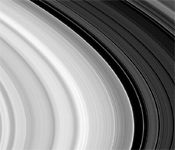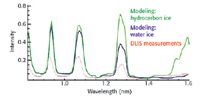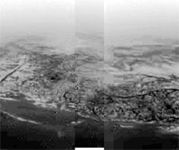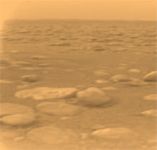GC–MS Analysis on Titan Mission
Special Issues
The European-built Huygens probe made history on January 14 by becoming the first spacecraft to land on Saturn's largest moon. The Huygens gas chromatography–mass spectrometry team concluded that methane rain occurs on the moon, and GC–MS can distinguish between two isotopic forms of carbon — carbon-12 and carbon-13. By comparing the carbon-12/13 ratios it might be possible to pin a biological source to the methane arising from the interior of Titan.
It took seven years and a journey of 2 billion miles for the $3.27 billion Cassini-Huygens spacecraft to reach Saturn and its 33 known moons. NASA, the European Space Agency, and the Italian Space Agency assembled the international mission in an effort to better understand the Saturnian system. However, to reach Saturn's largest moon Titan (bigger than both Mercury or Pluto) to deploy the Huygens probe, the Cassini-Huygens spacecraft made one of the most daring and spectacular maneuvers ever attempted by a spacecraft. It went directly through the 2170-mile-wide Cassini Division (Figure 1), a gap of empty space in the center of Saturn's enormous ring system. The rings themselves are made up of billions of pulverized ice and rock particles, ranging in size from grains of powdered flour to large boulders.

Figure 1. The Cassini/Huygens spacecraft's flight path took it through the middle of Saturn's Cassini Division (large black area) to deliver the Huygens probe to Titan. (Courtesy of JPL/NASA.)
On December 25, the Cassini mothership released the 702-lb Huygens probe on a 21-day coast to its encounter with Titan. Then on January 14, the probe entered the thick hazy atmosphere for a 2 1/2-hour descent to the surface. Titan's atmosphere extends about 10 times further into space (373 miles) than does Earth's. At approximately 111 miles above the surface of Titan a pilot parachute was deployed and the inlet ports were opened up for the aerosol collector pyrolyzer (ACP) and gas chromatography–mass spectrometry (GC–MS) instruments (Spectroscopy 17[12], 12 [2002]).
The Atmosphere of Titan
Some of the major scientific objectives of the Huygens mission included measuring winds and global temperatures, investigating cloud physics, and determining the physical state by photographing the topography and composition of the surface. However one of the first priorities was to determine the abundance of atmospheric constituents and measure their isotope ratios. Titan is thought to be a prebiotic world resembling what the Earth might have been like during its first billion years or so of its existence. However unlike the Earth 4.6 billion years ago, Titan is in a frozen state at a very cold –274 °F.

Figure 2. Spectrum taken by the DISR instrument from an altitude of about 100 m displaying the intensity of solar light reflected by the surface of Titan as a function of wavelength (color). The red line shows the measured intensity, which is compared here with the expected intensity of hydrocarbon ice (green) and dirty water ice (blue). (Courtesy of ESA, NASA, and the University of Arizona.)
Some of what makes up Titan's atmospheric already was known from flybys of Saturn and its moons with the Voyager 1 and 2 spacecraft along with numerous Earth-based telescope observations, as well as those carried out by the Hubble Space Telescope. Molecular nitrogen in Titan's atmosphere is about 93–99%, while methane was considered to be at about 0.5–3.4% with possibly 3% argon as well. The driving force of chemical evolution in Titan's atmosphere is the result of incoming solar wind, solar UV photons, and high-energy electrons from Saturn's magnetosphere. Direct photolysis by solar UV at 145 nm starts a complicated photochemical reaction that converts CH and H radicals that result in the production of acetylene (C2H2) and ethylene (C2H4) considered by many astrobiologists to be key ingredients to prebiotic organic chemistry.
It is known that acetylene drifts down to the stratosphere (186 miles altitude) and condenses in the troposphere (31 miles altitude) where complex hydrocarbons and nitriles are formed though their precise spatial distribution in the atmosphere is poorly understood. It is C2H6, C2H2, and other hydrocarbons including oxyacetylene that are thought to be responsible for coloring Titan's hazy brownish-orange atmosphere.

Figure 3. Titan mosaic image showing the boundary between the lighter-colored uplifted terrain, marked with what appear to be drainage channels, and darker lower areas. The images were taken from an altitude of about 8 km (about 5 miles) with a resolution of about 20 m (about 65 ft) per pixel. (Courtesy of NASA, ESA, ISA, and the University of Arizona.)
The major questions facing the Huygens science team were: What is the origin of the atmosphere? Where does the methane come from? How is water in a gas phase able to exist? Are there liquid methane rivers and oceans at the surface? Does organic chemistry on Titan involve oxygen atoms or life processes?
The Descent to the Surface
Five onboard batteries capable of generating 1800 W-h of electricity ensured that Huygens would last at least 153 min with another 3 min on Titan's surface if nothing went wrong. As the probe descended, at an altitude of 137 miles, the parachute deployment sequence began with a pyrotechnic mortar pulling out a pilot parachute that in turn pulled away the aft probe cover. Then a 27.2-ft diameter main parachute was deployed. Shortly after, the front heat shield was released and fell from the probe with a 30-s built-in delay to allow for the heat shield to clear and avoid any contamination of the GC–MS and ACP systems. The inlet ports were then open for the GC–MS and ACP systems to begin their analysis. The Descent Imager/Spectral Radiometer (DISR) cover was ejected 2 min later and captured its first panorama, and continued capturing images and spectral data throughout the descent.

Figure 4. Color view from the surface of Titan after processing to add reflection spectra data. (Courtesy of NASA, ESA, ISA, and the University of Arizona.)
Figure 2 shows a spectrum taken by the DISR at an altitude of approximately 100 m. In the infrared, above 1.4 nm, the measured intensity resembles more closely that of dirty water ice. At lower wavelengths, the fact that the expected intensity is greater than that observed suggests that the material making up the surface is darkened by impurities. This is the first clear measurement made of the surface of Titan and has not been contaminated by light scattered by the upper atmosphere.
At this time the Surface Science Package (SSP) also was switched on, taking measurements of atmospheric properties and soon the soil of Titan. The Huygens radio link with the Cassini mothership was activated early in the descent phase and while in range of Huygens signal listened for the next 3 h, then Cassini's high-gain antenna was turned away from Titan and beamed toward the Earth.
During the descent thorough Titan's atmosphere, the Huygens' Channel A and B cameras were programmed to take more than 1100 images down to the surface while the other scientific instruments sampled the atmosphere. However, due to a science team technical error, the A channel of the Descent Imager was not turned on and only 350 images were obtained throughout the sequence. Despite this glitch in the mission Huygens is being hailed as a phenomenal success.
The Discoveries so Far
Although it will take months for the science team to officially release their scientific papers and possibly many more years to analyze fully all the Huygens data, some of the early information already is telling us much about this strange world. The Descent Imager provided pictures of a hazy world with 350-ft high ridges of water ice surrounded by hills with river-channels running down to smooth dark plains of dry hydrocarbons (Figure 3). The Huygens GC–MS team concluded that methane rain occasionally drenches the hills thus washing ice and hydrocarbons down into the smooth dark plains areas seen in the images where they collect and dry out. Considering that the light at the surface of Titan is only 1% of the illumination of a sunlit Earth and the fact the Huygens DISR camera worked as well as it did was simply astonishing. Add to this that the data stream from the Huygens probe on the surface of Titan continued on for 70 min — far beyond the expected time of only 3 min.
The deceleration and penetration data from the Surface Science Package indicated that the probe had slightly sank in the soft surface material about 6 in., revealing a surface texture of analogous to wet sand mixed with ice. However, as the heat from the warm probe melted the soil–ice mixture under the lander the GC–MS and SSP spectrometers detected methane being released as a gas indicating that the methane was originating from below Titan's surface — an early major scientific finding.
Surface imagery at the landing site further revealed pebbles and small rocks strewn about. Infrared spectra obtained from the DISR camera showed these were consistent with the composition of rock hard water ice. Figure 4 shows a color view of from the surface of Titan after processing to add reflection spectra data. Pebbles initially thought to be rocks or ice blocks appear strewn about near the Huygens lander. The two rock-like objects just below the middle of the image are about 6-in. high (left) and about 1.5-in. (center) across respectively, at a distance of about 33 in. from Huygens. The surface is darker than originally expected, consisting of a mixture of water and hydrocarbon ice. There also is evidence of erosion at the base of these objects, indicating possible fluvial activity.
Another major finding by the Huygens GC–MS system was the detection of argon-40 arising from the decay of potassium-40 indicating to the science team that Titan does experience volcanic activity but unlike Earth where basaltic lava is the prime ingredient, Titan instead releases water ice and ammonia. This means that outgassing from Titan's interior is an ongoing process.
Chances of Life On Titan?
Although the surface temperatures on Titan would not allow for the survival of any known microbial life, astrobiologists have pondered the source of the methane. It is well know that without a source of constant replenishment of methane, Titan would have lost this gas in about 10,000 years. The GC–MS system on Huygens has indicated that methane is emanating from the interior of Titan, so is it possible that microbial life exists deep inside the moon? Some models of Titan's interior suggest there is an ocean of methane 62 miles deep about 200 miles below the surface. If true could methanogenic bacteria be producing the gas? While the Huygens team remains extremely skeptical about this, the GC–MS system does have the capability to distinguish two isotopic forms of carbon — carbon-12 and carbon-13. Methanogenic bacteria as well as all other known life forms on our planet incorporate carbon-12 while carbon-13 is not. By comparing the carbon-12/carbon-13 ratios it might be possible to pin a biological source to the methane arising from the interior of Titan. One thing is sure: the data returned from the Huygens probe will be studied for years to come.
Barry E. DiGregorio is an astrobiologist for the Cardiff Centre for Astrobiology in Wales, UK.

High-Speed Laser MS for Precise, Prep-Free Environmental Particle Tracking
April 21st 2025Scientists at Oak Ridge National Laboratory have demonstrated that a fast, laser-based mass spectrometry method—LA-ICP-TOF-MS—can accurately detect and identify airborne environmental particles, including toxic metal particles like ruthenium, without the need for complex sample preparation. The work offers a breakthrough in rapid, high-resolution analysis of environmental pollutants.
The Fundamental Role of Advanced Hyphenated Techniques in Lithium-Ion Battery Research
December 4th 2024Spectroscopy spoke with Uwe Karst, a full professor at the University of Münster in the Institute of Inorganic and Analytical Chemistry, to discuss his research on hyphenated analytical techniques in battery research.
Mass Spectrometry for Forensic Analysis: An Interview with Glen Jackson
November 27th 2024As part of “The Future of Forensic Analysis” content series, Spectroscopy sat down with Glen P. Jackson of West Virginia University to talk about the historical development of mass spectrometry in forensic analysis.
Detecting Cancer Biomarkers in Canines: An Interview with Landulfo Silveira Jr.
November 5th 2024Spectroscopy sat down with Landulfo Silveira Jr. of Universidade Anhembi Morumbi-UAM and Center for Innovation, Technology and Education-CITÉ (São Paulo, Brazil) to talk about his team’s latest research using Raman spectroscopy to detect biomarkers of cancer in canine sera.